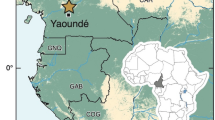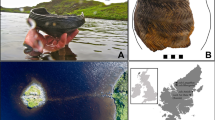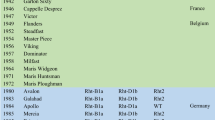Abstract
Barley (Hordeum vulgare L.) and wheat (Triticum monococcum L. and Triticum turgidum L.) were among the principal ‘founder crops’ of southwest Asian agriculture1. Two issues that were central to the cultural transition from foraging to food production are poorly understood. They are the dates at which human groups began to routinely exploit wild varieties of wheat and barley, and when foragers first utilized technologies to pound and grind the hard, fibrous seeds of these and other plants to turn them into easily digestible foodstuffs. Here we report the earliest direct evidence for human processing of grass seeds, including barley and possibly wheat, in the form of starch grains recovered from a ground stone artefact from the Upper Palaeolithic site of Ohalo II in Israel. Associated evidence for an oven-like hearth was also found at this site, suggesting that dough made from grain flour was baked. Our data indicate that routine processing of a selected group of wild cereals, combined with effective methods of cooking ground seeds, were practiced at least 12,000 years before their domestication in southwest Asia.
This is a preview of subscription content, access via your institution
Access options
Subscribe to this journal
Receive 51 print issues and online access
$199.00 per year
only $3.90 per issue
Buy this article
- Purchase on Springer Link
- Instant access to full article PDF
Prices may be subject to local taxes which are calculated during checkout



Similar content being viewed by others
References
Zohary, D. & Hopf, M. Domestication of Plants in the Old World, 3rd edn (Oxford Science Publications, Oxford, 2000)
Nadel, D. Ohalo II—A 23,000-Year-Old Fisher-Hunter-Gatherers' Camp on the Shore of the Sea of Galilee (Catalogue No. 20, Hecht Museum, Univ. Haifa, Haifa, 2002)
Nadel, D. & Werker, E. The oldest ever brush hut plant remains from Ohalo II, Jordan Valley, Israel. Antiquity 73, 755–764 (1999)
Nadel, D., Carmi, I. & Segal, D. Radiocarbon dating of Ohalo II: Archaeological and methodological implications. J. Archaeol. Sci. 22, 811–822 (1995)
Kislev, M. E., Nadel, D. & Carmi, I. Epipaleolithic (19,000 bp) cereal and fruit diet at Ohalo II, Sea of Galilee, Israel. Rev. Palaeobot. Palynol. 73, 161–166 (1992)
Weiss, E., Kislev, M. E., Simchoni, O. & Nadel, D. Small-grained wild grasses as staple foods at the 23,000 year old site of Ohalo II, Israel. Econ. Bot. (in the press)
Piperno, D. R., Ranere, A. J., Holst, I. & Hansell, P. Starch grains reveal early root crop horticulture in the Panamanian tropical forest. Nature 407, 894–897 (2000)
Pearsall, D. M., Chandler-Ezell, K. & Zeidler, J. A. Maize in ancient Ecuador: Results of residue analysis of stone tools from the Real Alto site. J. Archaeol. Sci. 31, 423–442 (2004)
Palmer, C. Milk and cereals; identifying food and food identity among Fellahin and Bedouin in Jordan. Levant 34, 173–195 (2002)
Hobbs, J. J. Bedouin Life in the Egyptian Wilderness (Univ. of Texas Press, Austin, 1992)
Nicolaisem, J. Ecology and Culture of the Pastoral Tuareg (Copenhagen National Museum, Copenhagen, 1963)
Jenkins, D. J. A. et al. Glycemic index: overview of implications in health and disease. Am. J. Clin. Nutr. 76, 266–273 (2002)
Foster-Powell, K., Holt, S. H. & Brand-Miller, J. C. International table of glycemic index and glycemic load values. Am. J. Clin. Nutr. 76, 5–56 (2002)
Stahl, A. in Foraging and Farming (eds Harris, D. R. & Hillman, G. C.) 171–194 (Unwin Hyman, London, 1989)
Wright, K. Ground-Stone tools and hunter-gatherer subsistence in southwest Asia: Implications for the transition to farming. Am. Antiq. 59, 238–263 (1994)
Kuhn, S. L. & Stiner, M. C. in Hunter-Gatherers: An Interdisciplinary Perspective (eds Painter-Brick, C., Layton, R. H. & Rowley-Conwy, P.) 99–142 (Cambridge Univ. Press, Cambridge, 2001)
Bar-Yosef, O. & Kislev, M. E. in Foraging and Farming: The Evolution of Plant Exploitation (eds Harris, D. R. & Hillman, G. C.) 633–642 (Unwin Hyman, London, 1989)
Flannery, K. V. in The Domestication and Exploitation of Plants and Animals (eds Ucko, P. J. & Dimbleby, G. W.) 73–100 (Duckworth, London, 1969)
Hawkes, K., O'Connell, J. F. & Rogers, L. The behavioral ecology of modern hunter-gatherers, and human evolution. Trends Ecol. Evol. 12, 29–32 (1997)
Kennett, D. & Winterhalder, B. in Foraging Theory and the Transition to Agriculture (eds Kennett, D. & Winterhalder, B.) (Smithsonian Institution Press, Washington DC, in the press)
Weiss, E., Wetterstrom, W., Nadel, D. & Bar-Yosef, O. The broad spectrum revolution revisited: Evidence from plant remains. Proc. Natl Acad. Sci. USA 101, 9551–9555 (2004)
Bar-Yosef, O. From sedentary foragers to village hierarchies: The emergence of social institutions. Proc. Br. Acad. 110, 1–38 (2001)
Reichert, E. T. The Differentiation and Specificity of Starches in Relation to Genera, Species, Etc. (Carnegie Institution of Washington, Washington DC, 1913)
Seidemann, J. Starke Atlas (Paul Parey, Berlin, 1966)
Cortello, A. R. & Pochettino, M. L. Starch grain analysis as a microscopic identification feature in the identification of plant material. Econ. Bot. 48, 171–181 (1994)
Perry, L. Starch analyses reveal the multiple functions of quartz ‘manioc’ grater flakes from the Orinoco Basin, Venezuela. Interciencia 27, 635–639 (2002)
Piperno, D. R. & Holst, I. The presence of starch grains on prehistoric stone tools from the lowland Neotropics: Indications of early tuber use and agriculture in Panama. J. Archaeol. Sci. 25, 765–776 (1998)
Torrence, R., Wright, R. & Conway, R. Identification of starch granules using image analysis and multivariate techniques. J. Archaeol. Sci. 31, 519–532 (2004)
Acknowledgements
Supported by the Smithsonian Tropical Research Institute (STRI), a grant to the STRI from the Andrew W. Mellon Foundation, the American School of Prehistoric Research (Peabody Museum), Harvard University and the National Museum of Natural History. We acknowledge the help of the following people and institutions for supplying the seed reference collection used in this study: E. Wood and D. Pfister (Harvard University Herbarium), the United States National Plant Germplasm System (North Central Regional Plant Introduction Station, Western Regional Plant Introduction Station and Plant Genetic Resources Conservation Unit), and the Royal Botanic Gardens, Kew (Seed Conservation Department). The Ohalo II project was supported by the Irene-Levi Sala CARE Archaeological project Foundation, the Israel Academy of Science, the Jerusalem Center for Anthropological Studies, the L.S.B. Leakey Foundation, the M. Stekelis Museum of Prehistory in Haifa, the MAFCAF Foundation, the National Geographic Society and the Israel Antiquities Authority.
Author information
Authors and Affiliations
Corresponding authors
Ethics declarations
Competing interests
The authors declare that they have no competing financial interests.
Supplementary information
Supplementary Information
Supplementary Figure 1. A typical starch grain population from Hordeum spontaneum; Supplementary Figure 2. Typical starch grains from Aegilops geniculata; Supplementary Figure 3. A typical starch grain population from Triticum dicoccoides; Supplementary Figure 4. A typical starch grain population from Hordeum marinum; Supplementary Figure 5. A typical starch grain population from Pisum sativum; Supplementary Figure 6. A typical starch grain from Potamogeton perfoliatus; Supplementary Figure 7. A typical starch grain from Ruppia maritima; Supplementary Figure 8. The arrangement of stones forming the oven feature at Ohalo II; Supplementary Table 1. Glycemic index of wheat and barley. (DOC 1116 kb)
Rights and permissions
About this article
Cite this article
Piperno, D., Weiss, E., Holst, I. et al. Processing of wild cereal grains in the Upper Palaeolithic revealed by starch grain analysis. Nature 430, 670–673 (2004). https://doi.org/10.1038/nature02734
Received:
Accepted:
Issue Date:
DOI: https://doi.org/10.1038/nature02734
This article is cited by
-
Identification of Neolithic diet by the morphology of the starch grains of dental calculus found in the Dehesilla Cave (Cadiz – South of the Iberian Peninsula)
Archaeological and Anthropological Sciences (2024)
-
Food, cooking and potteries in the Neolithic Mijiaya site, Guanzhong area, North China, revealed by multidisciplinary approach
Heritage Science (2023)
-
Tracing the human movements of three thousand years ago by volcanic grinding tools in the Final Bronze Age settlement of Monte Croce Guardia (Arcevia-Marche Region, central Italy)
Scientific Reports (2023)
-
Caribbean Deep-Time Culinary Worlds Revealed by Ancient Food Starches: Beyond the Dominant Narratives
Journal of Archaeological Research (2023)
-
Where the Grass is Greener — Large-Scale Phenological Patterns and Their Explanatory Potential for the Distribution of Paleolithic Hunter-Gatherers in Europe
Journal of Archaeological Method and Theory (2023)
Comments
By submitting a comment you agree to abide by our Terms and Community Guidelines. If you find something abusive or that does not comply with our terms or guidelines please flag it as inappropriate.



